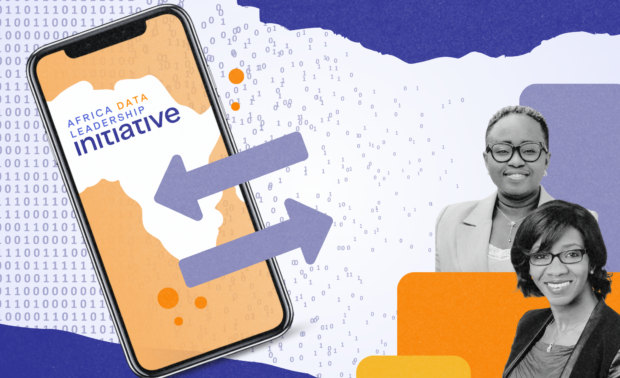By 2050, there will be 9.5 billion people on earth – 25% of whom will be living in Africa. In another 50 years, by 2100, it is projected that 40% of the world’s population will be in Africa. To put this growth into perspective – in 1950, Africa was less than 10% of the world population, while today, 40% of Africans are under 14 years old.
With rapid population growth, there will be an ever-increasing demand for things like health and education records, permits, and licenses, putting more strain on civil registries and government systems. Digital public infrastructure (DPI) is an approach that can help drive efficiency, scale, and access to these services. And as a better, faster, and cheaper approach to digital transformation that serves the public good, many African countries are increasingly recognizing DPI as an important area of investment.
In the second meeting of the ADLI cohort, participants engaged in an open discussion on what countries can learn from each other. To guide the conversation, we invited guest speakers:
- Dr. Talkmore Chidede, Senior Digital Trade Expert at the AfCFTA gave an overview of the African Continental Free Trade Agreement and its role in shaping national and regional digital and data strategies.
- Robert Karanja, Senior Director for Africa at Co-Develop discussed advancements in DPI throughout the continent and DPI’s role in supporting ambitions for a unified digital market.
The session started with an exploration of the countries defining their own approaches to designing and deploying DPI across the continent.
Participants discussed the African countries leading the way in their DPI implementation journeys.
There are 54 countries in Africa so naturally, there is no single digital strategy that spans the entire continent. Each country is unique and independent, with its own mix of languages, cultures, and geographies. And yet – participants emphasized the value of learning from each other and making use of existing initiatives and technologies.
The group discussed countries that are leading in various aspects of DPI:
Rwanda has long been a luminary in pursuing an open source first strategy across its digital transformation efforts. Since the establishment of its Smart Rwanda Master Plan (2015-2020), the Ministry of ICT has emphasized and prioritized the use of open data bases, open standards, and open-source digital solutions. Rwanda has been similarly progressive in building its DPI, best exemplified by its leading citizen portal IREMBO. The government continues to plan new use cases, prioritizing needs in agriculture and finance. And, as part of its ambitions to use DPI to drive inclusive economic development, the government has deployed Mojaloop as an instant and inclusive payment system.
Ghana has focused much of its efforts on building the enabling environment and supporting ecosystem for its DPI approach. Good DPI can be an effective vehicle for both public sector and private sector innovation, and Ghana has been especially adept at building itself up as a startup haven – especially in FinTech where digital payment platforms have helped to bring unbanked citizens into the financial sector and played a major role in remittances payments. Ghana is continuing to build out its digital infrastructure and is looking to open-source parts of it over time.
Tanzania is also building its own DPI stack, known as Jamii. The technology stack includes key platforms like Jamii Namba (digital ID), Jamii Malipo (digital payments), and Jamii Data Shirikishi (Jamii X-Change). A homegrown and built solution, Jamii supports government-to-person payments and addresses challenges in service delivery such as high transaction costs and limited access. The Government of Tanzania is planning to open-source the solution to encourage other countries in the region to use it as a basis for their DPI.
Somalia is using open-source tools to build GovNet, an inter-agency data exchange network that forms a secure connection between 15 different ministries. Somalia also launched the High School Certificate System, transforming a months-long manual certification process into an instant digital service that will enable up to 170,000 students annually to access and share their verified degrees instantly. The service was designed using open and interoperable building blocks like registration, identity verification, and consent.
Ethiopia boasts the second largest population on the continent and has witnessed an unprecedented growth in internet penetration. The government has already demonstrated a strong commitment to digital transformation through its Digital Ethiopia 2025 Strategy. Fayda, the country’s national ID program, is designed to provide a secure, interoperable identity system and streamline public service access for its population of more than 126.5 million. Similarly, its rapidly evolving mobile money ecosystem, including state backed Telebirr, is expanding financial inclusion with seamless digital transactions, bill payments, and social benefit transfers.
Morocco has embarked on an ambitious journey to integrate digital technologies into its educational system. Recognizing the transformative potential of digital tools in teaching and learning, the nation has taken significant steps to modernize its infrastructure and address the digital divide. Through the so-called GENIE program, the government is equipping public schools with a digital platform for student learning materials and specialized training for educators.
After highlighting the success of these exemplars, the ADLI group of civil servants, technologists, and policymakers discussed what lessons they can take from their peers on how to build sustainable and inclusive digital infrastructure in an African context.
Discussions surfaced important caveats and insights for national and regional digital strategies.
In sharing different points of view and posing questions, the ADLI cohort highlighted the practical realities and challenges of implementing foundational digital infrastructure.
Here are the top takeaways:
- Local ownership of digital systems is paramount. Pouring money into vendor-locked solutions will mean countries are reliant on vendors for change requests and updates. For this reason, an open-source strategy is important for countries to own the code behind their technology stacks and maintain agency over their digital futures. Additionally, from a cost perspective, outsourcing work to external vendors and organizations represents millions of dollars being shipped out of the country – where investment in homegrown solutions could pay higher dividends.
- New digital services can and should be integrated with existing legacy systems. While countries are picking up the DPI approach to building open, secure, and sustainable digital infrastructure, long-existing investments in digital infrastructure should not be automatically sunset. In some cases, legacy systems can be integrated into the broader DPI ecosystem. For example, the mobile money system MPesa was launched in 2007 in Kenya. It was not built as part of the country’s DPI approach, but it operates in a way that is well aligned. Once it becomes fully interoperable, other mobile wallets should be aiming to integrate it as part of an open ecosystem.
- Achieving cross-border digital payments will require collaboration with regulators. Cross-border digital payments remain a challenge, as many central banks are conservative by nature and may be more apprehensive about emerging technologies. Overcoming this challenge requires close engagement with regulators. Regulations in both the banking and telecom sectors need to be in place to enable money to move freely across borders.
- DPI is not a pill that will cure all ailments. Even for basic digital transformation, countries need to have adopted certain levels of digital infrastructure. Sufficient energy and physical infrastructure like internet cables are most often prerequisites for setting up DPI. However, when gaps exist, people innovate around them. Somalia, for example, has one of the lowest connectivity rates and yet has one of the most advanced mobile money ecosystems in the world.
The learning continues as we bring together the leaders shaping Africa’s digital future.
Investments in DPI can lay a strong foundation for countries to capitalize on the digital economy while providing people with more efficient essential services. As we move on from this discussion of DPI exemplars, next week’s session will focus on the essential topic of how to build trustworthy and legitimate data systems.
We will continue to share insights from the peer-learning sessions each week. Following along on LinkedIn to stay informed.




